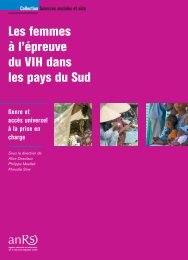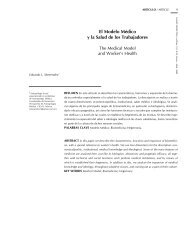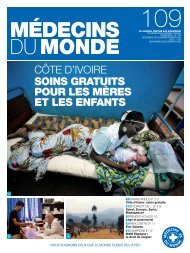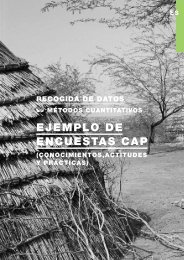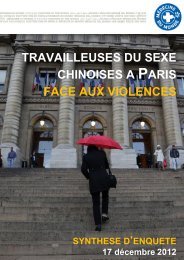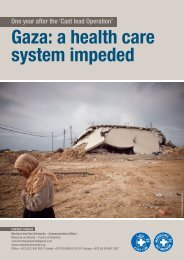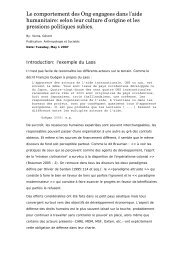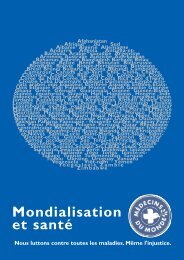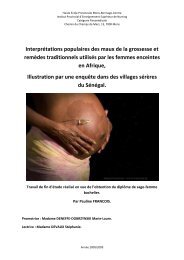harm reduction program sensitization to harm reduction (tanzanie)
harm reduction program sensitization to harm reduction (tanzanie)
harm reduction program sensitization to harm reduction (tanzanie)
Create successful ePaper yourself
Turn your PDF publications into a flip-book with our unique Google optimized e-Paper software.
Presentation 4 « The organization of the administration of thedistrict and police Services and their relation with the IDUs”, Dr.Mashombo Mkamba, Health Research Coordina<strong>to</strong>r/Municipal Direc<strong>to</strong>rrepresentative Temeke district CouncilPresentation was about- Probable fac<strong>to</strong>rs leading <strong>to</strong> drug use- Handling of drug abuse crisis at municipal level- Challenges caused by drug use- Way forward for drug useAfter all those presentations, a film was shown, which describes the real life of drug users,especially those who are injecting, how they inject drug in their body, what they feel andexpress concerning their life as injecting drug users, what challenges they face in thecommunity and support they need in their life as drug users.Presentation 5 « The police and Injecting Drug Users in Temekeregion”, Mr Misime, Regional Police Commissioner at Temeke Zone.Before starting presented his presentation, RPC congratulated MdM for its <strong>program</strong> whichwill serve most of IDUs in Temeke district because it is a leading region for drug users, andthe most affected people are youth who shall support the production of the nation.Presentation was about- Causes of drug use- How polices handle drug addicts or user.Questions after presentationi. How are outreach workers able <strong>to</strong> reach easily drug users in their camps, discusswith them avoiding drug users running away?ii. How can police control corruption <strong>to</strong> drug dealers?iii. As a police station when drug luggage caught, is it taken <strong>to</strong> chemist for check upand testing in order <strong>to</strong> know which kind of drug?iv. Why do policemen treat drug users as a criminal? Which punishment?v. Policemen always use law when a drug user is caught, but as the police when doyou use law and counseling with drug user?Comments and answersThere should be a special department at police station that deals with drugs.We have <strong>to</strong> work cooperative in each organization in order <strong>to</strong> combat drugproblem.Immigration officers at country borders have <strong>to</strong> work seriously with drug dealers.Everybody should be responsible <strong>to</strong> fight against drug use.
Drugs when caught, are tested with kits that identify what kind of drugs can beheroin, marijuana or cocaine or can be sent <strong>to</strong> general chemist for checking.Presentation 6 « Drug Abuse and HIV/AIDS”, Mr Alpher Kiloti,TAYOHAG (Tandiaka Youth Handcraft Group)Presentation was about His<strong>to</strong>ry of TAYOHAG and its activities in the community at TandikaWard.Questions after presentationi. How TAYOHAG can work <strong>to</strong>gether with MdM without any conflict that might rise inorder <strong>to</strong> serve IDUs?ii. Is your <strong>program</strong> (TAYOHAG) reaching <strong>to</strong> schools in order <strong>to</strong> educate pupils?Because most of them starting while at school.iii. How does Temeke hospital try <strong>to</strong> provide services <strong>to</strong> IDUs without stigma?iv. How does FHI support TAYOHAG and in which areas?v. Are IDUs telling outreach workers who/ and where they get drugs? Becauseoutreach workers can reach them easily.vi. What plan TAYOHAG may have <strong>to</strong> show the film <strong>to</strong> the community in order <strong>to</strong>sensitize the parents?vii. What makes you as TAYOHAG <strong>to</strong> deal with drug users?Comments and answersTAYOHAG deals with drug users because, most of TAYOHAG workers were drugusers before and got enough education on drugs , that’s why they decided <strong>to</strong> initiatethe organization that will help their fellow youths who are drug users <strong>to</strong> quit fromusing drugs.MdM may help TAYOHAG in preventing HIV transmission <strong>to</strong> IDUs by providing kitsfor IDUs and educate <strong>to</strong> treat abscesses, counseling.Some of the schools in Temeke district have been sensitized on drugs by TAYOHAGbut not all.IDUs get syringes from medical shops and or sometimes they reuse a syringe.TAYOHAG sometime conduct <strong>sensitization</strong> campaign in the community bycooperating with different NGOs. For example, they did <strong>sensitization</strong> campaign withUMATI at Sandale ward were also there was VCT services provided.Helping the community/parents: some parents bring their children who are drugaddicted at TAYOHAG center for more.No official partnership between MdM and TAYOHAG, but later MdM will see how andwhere they will help TAYOHAG.Presentation 7 ” The Community and Drug Abuse”, Mr Salum M.Mapande, POVERTY FIGHTER,Presentation was about
- Poverty Fighter his<strong>to</strong>ry and Collaboration with other NGO within Temeke District onDrug Abuse,- Poverty Fighter Activities in the community and Challenges facing the Organization.Comments Small NGOs should have a system of preparing a report monthly or at leastquarterly in order municipal council could get actual data. Small NGOs don’t have a system of recording or keeping data of what they areworking on. So they should be helped on that.Presentation 8 “Introduction of MdM”, Dr Patrick Beauverie, MdMFrance.Presentation was about How MdM implements different <strong>program</strong>s around the world.A film was shown. Dr Beauverie also described how Harm Reduction <strong>program</strong> started inFrance, the challenges it faced and how drug users reacted during the initiation processes ofthe <strong>program</strong>.Thereafter, Dr. Patrick Beauverie carried on presenting about;- When MdM started until this year 2010.- Successes of MdM like needle exchange <strong>program</strong> (more organization started <strong>to</strong>implement needle exchange <strong>program</strong>), how they initiated non and mobile servicesclinic <strong>to</strong> IDUs and forgotten people.According <strong>to</strong> Dr. Patrick Beauverie presentation, MdM;- Goes where others don’t go <strong>to</strong> provide health services.- Acts where there is nothing or not enough in regards <strong>to</strong> <strong>harm</strong> <strong>reduction</strong> or communityhealth.- Intervenes with and <strong>to</strong>wards drug users as closely as responsible <strong>to</strong> production ortrafficking areas.- Testifies the importance of social and economical disruptions on the emergence ofnew practices.Presentation 9 “The Project in Serbia”, Celine Debaulieu, ProgramCoordina<strong>to</strong>r, MdM Tanzania.Presentation was about- MdM project in Serbia since 2002 (until now 1600 beneficiaries came <strong>to</strong> the <strong>program</strong>from which 20% are women).- Staffs were mixed team like IDUs, active IDUs and nurses.- Outreach activities (Mobile Unit) and fixed place (Drop in Centre)- Provision of medical care, HIV and hepatitis testing, referrals <strong>to</strong> health care services.- 25% of the beneficiaries came were Roma people.
- Implementation of opiates substitution therapy was done.- At the end of the <strong>program</strong>, the <strong>program</strong> was handed over <strong>to</strong> a local NGO.Presentation 10 “MdM in Tanzania: 17 years in Kagera region”,Stéphanie Derozier, Desk Officer, MdM FrancePresentation was about <strong>program</strong>s MdM has been implementing for 17 years in TanzaniaPresentation 11 “MdM in Temeke District”, Dr Fatima Assouab,Responsible of Mission, MdM FrancePresentation was about- MdM wishes <strong>to</strong> focus on Most at Risks Population (MARPS) because the epidemic ofHIV/AIDS risks associated with injection drug use requires innovative HIV prevention<strong>program</strong>.- Objectives of the <strong>program</strong> are NSEP, condom distribution, IEC, VCT, Vaccination,and hepatitis services.- Activities which will be done by the <strong>program</strong> are HIV testing and counseling <strong>to</strong> IDUs,referral services <strong>to</strong> HIV treatment and care, training of personnel at referralinstitutions, and training IDUs <strong>to</strong> be peer educa<strong>to</strong>rs.- Working with partners who are national authorities, MOHSW, drug controlcommission, TACAIDS, local authorities, local NGOs, TAYOHAG, POVERTYFIGHTERS, and UN agencies.QUESTIONS AFTER THE 3 PRESENTATIONSi. In Serbia and Afghanistan MdM worked on HR in reducing HIV infection among IDUsand succeeded, in Tanzania there is a critical law <strong>to</strong> drug users, how MdM will help <strong>to</strong>moderate it in order <strong>to</strong> serve drug users?ii. In your <strong>program</strong> (MdM) we saw you integrated different partners, how did youcooperate with police and in Tanzania how will you work with police because they arefeared by drug users?iii. Why did MdM decide <strong>to</strong> implement its HR <strong>program</strong> in Temeke district and not otherparts of Tanzania?iv. What is the meaning of “Medecins Du Monde”?v. What plans does MdM have <strong>to</strong> employ local medical doc<strong>to</strong>rs because there areothers who know both Kiswahili and English languages?COMMENTS AND ANSWERS When there will be another workshop, MdM should not forget <strong>to</strong> invite court peoplebecause they are the ones who enforce laws and judge mistakes. MdM doesn’t have data on how many people use drugs in Tanzania, only has access<strong>to</strong> published studies.
There should be a seminar for all police commissioners on how MdM can cooperatewith them on HR <strong>program</strong>.In Morocco country, MdM outreach workers entered in the community, met with localleaders and discuss with them on how they will fight against drug use.Temeke district selected because, MdM planned <strong>to</strong> work with all Dar es Salaamregion but other districts are <strong>to</strong> be covered by other NGOs.B. DAY 2Film Presentation “Fix”, Céline Debaulieu, Program Coordina<strong>to</strong>r,MdM Tanzania.- The film was about introduction <strong>to</strong> Harm Reduction in Canada, in Vancouver City. Themain objective of the film was <strong>to</strong> share experience and knowledge on advocating forHarm Reduction <strong>program</strong>.- The film ‘Fix’ is the s<strong>to</strong>ry of an addicted city and how IDUs advocated for HarmReduction <strong>program</strong>. It also shared how they faced some obstacles during initiation ofthe <strong>program</strong>.Discussion and questionsi. Was Mr. Dean able <strong>to</strong> quit from drug use?ii. For Vancouver city most of people are literate, will it be possible for Temeke people <strong>to</strong>understand and accept about NSEP for safe injection <strong>program</strong>?iii. After safe injection center opened in Vancouver city, how much HIV infection wasreduced?iv. What measure did Vancouver government take for safe injection center?v. Would NSEP not be a way of motivating more people <strong>to</strong> use drugs?Comments and Answers If the community will be sensitized on safe injection <strong>program</strong>, Temeke people willunderstand the <strong>program</strong> because it is not a matter of literacy but education andinformation. HR <strong>program</strong> will be favorable for our country according <strong>to</strong> the laws and culture of thepeople. If drop in center will be opened at MdM office, not any drug will be given or provided<strong>to</strong> drug users who will come there for services. MdM Tanzania will not provide methadone at DIC but it will be provided in the hospitalidentified by trained and professional medical doc<strong>to</strong>rs as per other stakeholder’splans. There should be syringes provided <strong>to</strong> IDUs so that they don’t reuse syringes
Group Work Harm ReductionAfter the discussion, participants divided in<strong>to</strong> four groups where by they did group work andanswered some question concerning Harm Reduction <strong>program</strong> and later each grouppresented its work.Group 1Questions:- What are the effects of syringe sharing?- What is the importance of providing education <strong>to</strong> IDUs?- What do you think will be the obstacles for Harm Reduction <strong>program</strong>, obstacles <strong>to</strong>initiate HR and comments <strong>to</strong> overcome obstacles?Answers:- Q1 Infection of different diseases like HIV, Hepatitis and abscess- Q2 Increase knowledge for Drug users Will minimize the cost of caring for infected person <strong>to</strong> the government will increase manpower- Q3 Misconception of the drug Level of understanding Resistance <strong>to</strong> change <strong>to</strong> most of human-being Tanzania laws on drugs Stigmatization of drug users in the community. Resistance from drug users. Lack of professional staff <strong>to</strong> the <strong>program</strong> No policies <strong>to</strong> support <strong>harm</strong> <strong>reduction</strong> <strong>program</strong> No working <strong>to</strong>ols.Comments from Q3: Enough education should be provided from the grass root people Engagement of all stakeholders in the community – e.g . Religious Leaders Drop in centre should be opened in all <strong>program</strong> sites.Group 2Questions:- What is methadone?- What are the obstacles might rise <strong>to</strong> initiate methadone?- Recommend on methadone.Answers:- Q1 Is a medicine- Q2 Lack of understanding among the community- Q3 Mobilization and <strong>sensitization</strong> on the importance of methadone Increase the number of professional with substance use knowledge.
Group 3Questions:- Who is peer educa<strong>to</strong>r?- Mention role of peer educa<strong>to</strong>r?- What <strong>to</strong>pics that PE should be taught?Answers:- Q1- Q2- Q3Peer educa<strong>to</strong>r is a person who provides education <strong>to</strong> the people of his or her sameage whom they share culture, environment and level of education.To provide education in his/her communityTo sensitize/mobilize his peer in different issues e.g. health and environmentalissues, culture etc.Life skillsHIV/AIDS and STIsDrug AbuseReproductive healthGroup 4Questions:- Mention stakeholders and their responsibilities <strong>to</strong> IDUs.Answers: Hospitals, health centres and dispensarieso Make treatment available and accessible <strong>to</strong> IDUso HIV and hepatitis testingo Guidance and counseling <strong>to</strong> IDUs NGOs, FBOs and CBOso Community <strong>sensitization</strong> on drugs <strong>harm</strong> and effectso Guidance and counselingo Referral of IDUs <strong>to</strong> other serviceso Identification of IDUs Local Government Authorities and Central Governmen<strong>to</strong> Identification of IDUs in their communityo Sensitization <strong>to</strong> the community on drug <strong>harm</strong>o Referral of IDUs <strong>to</strong> other services Communityo Guidance and care <strong>to</strong> their childreno Campaign against stigmatization <strong>to</strong> IDUso Referral of IDUs <strong>to</strong> other services.Recommendations1. Create networking with other NGOs that deal with drugs2. Stakeholders quarterly regular meetings in order <strong>to</strong> share experiences, knowledge ondrugs users and sometimes <strong>to</strong> avoid elapse services
3. Ward offices should get a report from each NGO within his/her ward,4. Information sharing among NGOs for updating each other in different issues arise.5. To have a same referral form for further servicesENDING WORKSHOPAt the end of workshop, MdM team thanked the participants of the workshop and advisedthem <strong>to</strong> send a message and share knowledge and experience on what they learnt from theworkshop <strong>to</strong> other people who were not able <strong>to</strong> attend the workshop.Also the chairman of the workshop. Dr. Mashombo Mkamba insisted that participants shallbe cooperative when the <strong>program</strong> starts, share experience with MdM on how they could workand help the community <strong>to</strong> understand about Harm Reduction <strong>program</strong> and its objective intheir community.It was stated that Needle exchange <strong>program</strong> could greatly help Tanzania because it is costefficient and would prevent new infection and thus decrease in ARV treatment budget.This workshop has been the first one on the list of the numerous next workshops <strong>to</strong> come inthe future of MdM’s <strong>program</strong> in Temeke. For any further information, you are welcome in:MDM OFFICE IN DAR ES SALAMMdM, opposite soko la maguruwe, Tandika, TemekePO box 105948LIST OF DOCUMENTS DISTRIBUTED- Definition on Harm Reduction- Substance Use and HIV/AIDS in Tanzania



